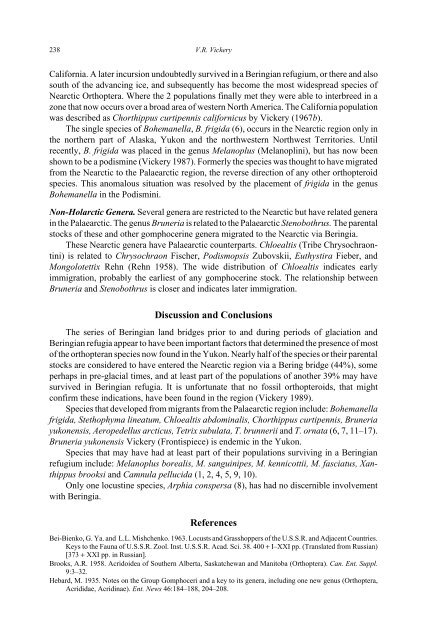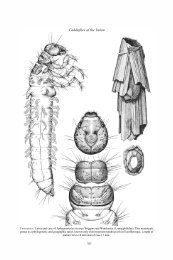Orthopteroids (Orthopteroidea) of the Yukon (V.R. Vickery)
Orthopteroids (Orthopteroidea) of the Yukon (V.R. Vickery)
Orthopteroids (Orthopteroidea) of the Yukon (V.R. Vickery)
Create successful ePaper yourself
Turn your PDF publications into a flip-book with our unique Google optimized e-Paper software.
238 V.R. <strong>Vickery</strong><br />
California. A later incursion undoubtedly survived in a Beringian refugium, or <strong>the</strong>re and also<br />
south <strong>of</strong> <strong>the</strong> advancing ice, and subsequently has become <strong>the</strong> most widespread species <strong>of</strong><br />
Nearctic Orthoptera. Where <strong>the</strong> 2 populations finally met <strong>the</strong>y were able to interbreed in a<br />
zone that now occurs over a broad area <strong>of</strong> western North America. The California population<br />
was described as Chorthippus curtipennis californicus by <strong>Vickery</strong> (1967b).<br />
The single species <strong>of</strong> Bohemanella, B. frigida (6), occurs in <strong>the</strong> Nearctic region only in<br />
<strong>the</strong> nor<strong>the</strong>rn part <strong>of</strong> Alaska, <strong>Yukon</strong> and <strong>the</strong> northwestern Northwest Territories. Until<br />
recently, B. frigida was placed in <strong>the</strong> genus Melanoplus (Melanoplini), but has now been<br />
shown to be a podismine (<strong>Vickery</strong> 1987). Formerly <strong>the</strong> species was thought to have migrated<br />
from <strong>the</strong> Nearctic to <strong>the</strong> Palaearctic region, <strong>the</strong> reverse direction <strong>of</strong> any o<strong>the</strong>r orthopteroid<br />
species. This anomalous situation was resolved by <strong>the</strong> placement <strong>of</strong> frigida in <strong>the</strong> genus<br />
Bohemanella in <strong>the</strong> Podismini.<br />
Non-Holarctic Genera. Several genera are restricted to <strong>the</strong> Nearctic but have related genera<br />
in <strong>the</strong> Palaearctic. The genus Bruneria is related to <strong>the</strong> Palaearctic Stenobothrus. The parental<br />
stocks <strong>of</strong> <strong>the</strong>se and o<strong>the</strong>r gomphocerine genera migrated to <strong>the</strong> Nearctic via Beringia.<br />
These Nearctic genera have Palaearctic counterparts. Chloealtis (Tribe Chrysochraontini)<br />
is related to Chrysochraon Fischer, Podismopsis Zubovskii, Euthystira Fieber, and<br />
Mongolotettix Rehn (Rehn 1958). The wide distribution <strong>of</strong> Chloealtis indicates early<br />
immigration, probably <strong>the</strong> earliest <strong>of</strong> any gomphocerine stock. The relationship between<br />
Bruneria and Stenobothrus is closer and indicates later immigration.<br />
Discussion and Conclusions<br />
The series <strong>of</strong> Beringian land bridges prior to and during periods <strong>of</strong> glaciation and<br />
Beringian refugia appear to have been important factors that determined <strong>the</strong> presence <strong>of</strong> most<br />
<strong>of</strong> <strong>the</strong> orthopteran species now found in <strong>the</strong> <strong>Yukon</strong>. Nearly half <strong>of</strong> <strong>the</strong> species or <strong>the</strong>ir parental<br />
stocks are considered to have entered <strong>the</strong> Nearctic region via a Bering bridge (44%), some<br />
perhaps in pre-glacial times, and at least part <strong>of</strong> <strong>the</strong> populations <strong>of</strong> ano<strong>the</strong>r 39% may have<br />
survived in Beringian refugia. It is unfortunate that no fossil orthopteroids, that might<br />
confirm <strong>the</strong>se indications, have been found in <strong>the</strong> region (<strong>Vickery</strong> 1989).<br />
Species that developed from migrants from <strong>the</strong> Palaearctic region include: Bohemanella<br />
frigida, Stethophyma lineatum, Chloealtis abdominalis, Chorthippus curtipennis, Bruneria<br />
yukonensis, Aeropedellus arcticus, Tetrix subulata, T. brunnerii and T. ornata (6, 7, 11–17).<br />
Bruneria yukonensis <strong>Vickery</strong> (Frontispiece) is endemic in <strong>the</strong> <strong>Yukon</strong>.<br />
Species that may have had at least part <strong>of</strong> <strong>the</strong>ir populations surviving in a Beringian<br />
refugium include: Melanoplus borealis, M. sanguinipes, M. kennicottii, M. fasciatus, Xanthippus<br />
brooksi and Camnula pellucida (1, 2, 4, 5, 9, 10).<br />
Only one locustine species, Arphia conspersa (8), has had no discernible involvement<br />
with Beringia.<br />
References<br />
Bei-Bienko, G. Ya. and L.L. Mishchenko. 1963. Locusts and Grasshoppers <strong>of</strong> <strong>the</strong> U.S.S.R. and Adjacent Countries.<br />
Keys to <strong>the</strong> Fauna <strong>of</strong> U.S.S.R. Zool. Inst. U.S.S.R. Acad. Sci. 38. 400 + I–XXI pp. (Translated from Russian)<br />
[373 + XXI pp. in Russian].<br />
Brooks, A.R. 1958. Acridoidea <strong>of</strong> Sou<strong>the</strong>rn Alberta, Saskatchewan and Manitoba (Orthoptera). Can. Ent. Suppl.<br />
9:3–32.<br />
Hebard, M. 1935. Notes on <strong>the</strong> Group Gomphoceri and a key to its genera, including one new genus (Orthoptera,<br />
Acrididae, Acridinae). Ent. News 46:184–188, 204–208.
















